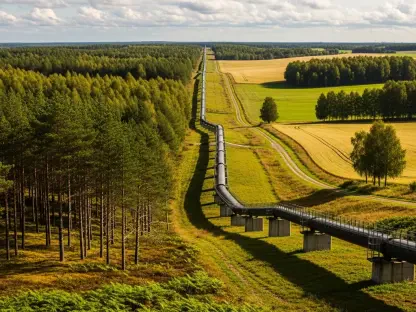The landscape of transportation in the United States is on the cusp of a revolutionary shift, with autonomous vehicles (AVs) poised to redefine how people and goods move across the nation, promising a future where bustling city streets are filled with cars gliding silently without human drivers. Imagine navigating complex intersections with precision—a vision no longer confined to science fiction but becoming a tangible reality in limited areas. This transformation, driven by cutting-edge technology, has caught the attention of lawmakers who are now grappling with the urgent need to establish safety regulations for these driverless systems. As the AV industry accelerates, the upcoming surface transportation reauthorization bill emerges as a critical platform to address the balance between innovation and public safety, setting the stage for a pivotal debate in Congress.
The Rise of Autonomous Vehicles in the U.S. Transportation Landscape
Autonomous vehicles represent a transformative force in the transportation sector, promising to enhance efficiency, reduce accidents caused by human error, and reshape urban mobility. Currently, the industry is characterized by rapid advancements, with technologies ranging from Level 3 automation—where vehicles can handle most driving tasks but require human intervention in certain scenarios—to Level 5, which envisions fully driverless operation under all conditions. While no Level 5 vehicles are yet deployed on public roads, significant progress has been made at Level 4, with companies like Waymo operating robo-taxi services in select cities such as Phoenix and San Francisco.
Major players, including Tesla with its advanced driver-assistance systems and traditional automakers investing heavily in AV research, are driving competition and innovation in this space. Deployment remains limited to specific geographic areas due to regulatory and safety constraints, but pilot programs and testing initiatives are expanding. This gradual integration highlights the potential for AVs to become a cornerstone of future transportation, provided that regulatory frameworks can keep pace with technological developments.
The significance of AVs extends beyond convenience, touching on broader societal impacts such as reduced traffic congestion and improved accessibility for individuals unable to drive. As testing and deployment grow, the industry’s role in transforming the transportation landscape becomes increasingly evident, prompting urgent discussions among policymakers to ensure that this evolution unfolds safely and equitably across the nation.
Current Trends and Industry Dynamics
Emerging Technologies and Safety Priorities
The rapid evolution of AV technology is marked by breakthroughs in artificial intelligence, sensor systems, and machine learning, enabling vehicles to interpret complex environments with remarkable accuracy. However, as these advancements accelerate, safety remains a paramount concern for both industry stakeholders and the public. High-profile incidents involving autonomous systems have underscored the need for robust safety protocols, pushing manufacturers to prioritize fail-safe mechanisms and real-time decision-making capabilities in their designs.
Public trust in AVs is another critical factor shaping the industry’s trajectory, with transparency emerging as a key demand. Consumers and advocacy groups are calling for clear information on how these vehicles operate, especially in edge-case scenarios where split-second decisions are required. This emphasis on openness presents an opportunity for companies to differentiate themselves by integrating user-friendly interfaces and detailed performance metrics into their offerings.
Innovation in AV design also offers a pathway to address safety concerns, with developments such as enhanced cybersecurity measures and redundant systems gaining traction. As the technology matures, the focus on safety is expected to drive collaboration between industry leaders and regulators, ensuring that advancements do not outpace the ability to protect road users. This dynamic interplay between technology and safety priorities continues to define the sector’s growth.
Market Growth and Legislative Momentum
Data on AV testing reveals a staggering scale of progress, with industry reports indicating that over 145 million miles have been driven in autonomous mode across various testing programs. Market projections suggest significant growth in deployment over the next few years, with estimates pointing toward widespread adoption in urban centers by the end of this decade. Such figures highlight the momentum behind AVs and the pressing need for regulatory clarity to support this expansion.
Legislative efforts are gaining traction as policymakers recognize the importance of integrating AV rules into broader transportation policies. Bipartisan support in Congress, particularly in the House, signals a commitment to addressing the regulatory gaps that currently hinder industry scalability. The upcoming surface transportation reauthorization bill is seen as a key opportunity to establish national standards, fostering an environment where innovation can thrive without compromising safety.
Looking ahead, the alignment of market growth with legislative action offers a promising outlook. If successful, these efforts could position the United States as a leader in AV technology, provided that lawmakers can navigate the complexities of balancing industry needs with public interest. The momentum in both market and policy spheres underscores the critical juncture at which the AV sector currently stands.
Challenges in Regulating Driverless Vehicles
The path to effective AV regulation is fraught with obstacles, chief among them being the absence of a unified federal framework. Currently, a patchwork of state-level regulations governs AV testing and deployment, creating inconsistencies that complicate interstate operations and hinder scalability for manufacturers. This fragmented approach has led to calls for national standards to streamline compliance and ensure uniform safety measures.
Another significant challenge lies in the slow pace of regulatory progress by federal agencies such as the National Highway Traffic Safety Administration (NHTSA). Despite announcements of forthcoming AV frameworks, comprehensive safety rules for highly and fully autonomous vehicles remain elusive, frustrating lawmakers and industry stakeholders alike. This delay exacerbates the risk of uneven safety standards, potentially undermining public confidence in the technology.
Potential solutions to these hurdles include the development of standardized safety certifications that can be applied nationwide, alongside mandates for increased data transparency from AV manufacturers. By requiring detailed reporting on performance metrics such as collision rates and system failures, regulators could better assess and mitigate risks. Addressing these challenges will require coordinated efforts between government bodies and industry players to create a cohesive regulatory environment that supports innovation while prioritizing safety.
Legislative Efforts and Regulatory Landscape
A significant push is underway to incorporate AV safety regulations into the surface transportation reauthorization bill, with strong bipartisan backing in the House. Lawmakers from key committees, including Energy and Commerce and Transportation and Infrastructure, are advocating for provisions that address vehicle design, performance standards, and cybersecurity risks. This collaborative approach reflects a shared understanding of the need to establish federal oversight for an industry with interstate implications.
Specific proposals, such as HR 4376, aim to enhance transparency by mandating detailed data reporting from AV manufacturers, covering metrics like miles traveled and unplanned stops. Such measures are intended to provide regulators and the public with a clearer picture of AV safety relative to human-driven vehicles. However, while the House demonstrates momentum, skepticism in the Senate regarding rapid deployment and potential job displacement introduces uncertainty into the legislative process.
Regulatory delays at the federal level further complicate the landscape, with criticism directed at NHTSA for not finalizing comprehensive guidelines. The divergence between House enthusiasm and Senate caution, coupled with bureaucratic inertia, suggests that achieving consensus on AV policy will be a complex endeavor. Nevertheless, the inclusion of these regulations in the transportation bill remains a focal point for shaping the industry’s future.
Future Outlook for Autonomous Vehicle Policy
The trajectory of AV regulation is likely to be influenced by several factors, including the pace of emerging technologies and the growing importance of cybersecurity in vehicle systems. As AVs become more integrated into transportation networks, protecting against digital threats will be critical to maintaining public trust and operational integrity. Additionally, global competition, particularly with nations like China advancing their own AV initiatives, adds pressure for the United States to establish a competitive regulatory framework.
Economic concerns, such as the potential displacement of jobs in sectors like trucking and for-hire transportation, will also play a pivotal role in shaping policy. Lawmakers must navigate these challenges while addressing public apprehensions about safety and automation’s broader societal impacts. The balance between fostering innovation and mitigating economic disruption will be a defining issue in the coming years, influencing both legislative priorities and market trends.
On the international stage, maintaining leadership in AV technology will require strategic investments and policies that encourage research while ensuring safety standards are not compromised. As the regulatory landscape evolves, the interplay of technological, economic, and geopolitical factors will determine how effectively the United States can harness the potential of autonomous vehicles. This multifaceted outlook highlights the need for adaptable and forward-thinking governance in this space.
Conclusion and Path Forward
Reflecting on the insights gathered, it becomes clear that the debate over autonomous vehicle regulation has reached a critical turning point, with lawmakers and stakeholders striving to reconcile innovation with safety and economic stability. The urgency to establish a national framework is evident, as fragmented state regulations and slow federal progress pose significant barriers to the industry’s growth. Bipartisan efforts in the House have laid a strong foundation for integrating AV rules into the transportation bill, though Senate skepticism introduces notable friction.
Moving forward, an actionable step would be to prioritize the development of standardized safety certifications that can be uniformly applied, ensuring consistency across jurisdictions. Encouraging transparency through mandatory data reporting is also seen as vital to building public trust, an aspect that could be bolstered by engaging communities in dialogue about AV benefits and risks. Furthermore, addressing job displacement fears through retraining programs and economic transition plans emerges as a necessary consideration to ease societal tensions.
Ultimately, the path ahead demands a collaborative approach, uniting government, industry, and the public to craft policies that support technological advancement without sacrificing safety or equity. Establishing dedicated task forces to monitor global AV trends and adapt regulations accordingly is identified as a strategic move to maintain a competitive edge. These steps, if pursued diligently, hold the promise of transforming the transportation landscape into one that is safer, more efficient, and inclusive for all.








